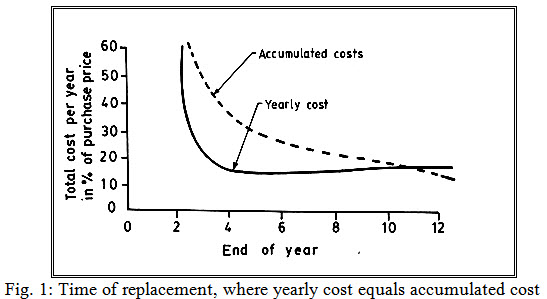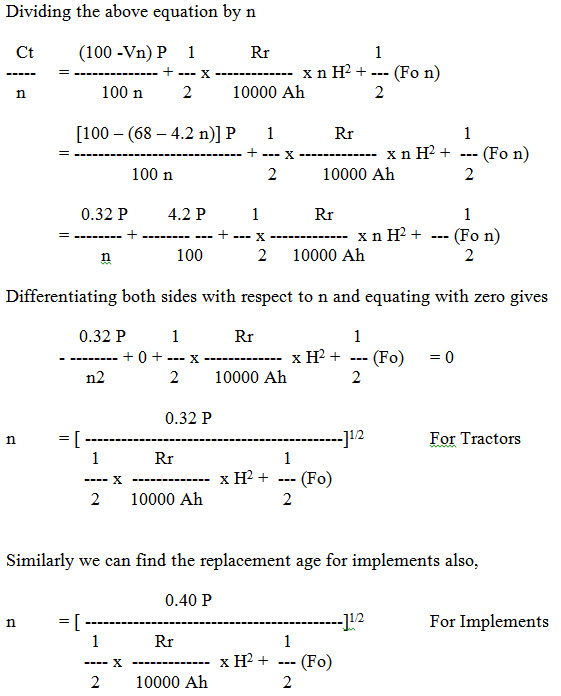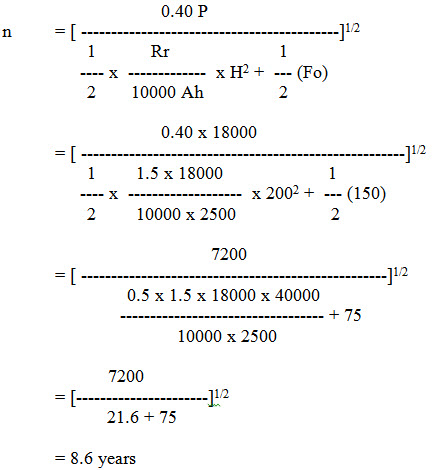Site pages
Current course
Participants
General
Module 1. Role of mechanization and its relationsh...
Module 2. Performance and power analysis
Module 3. Cost analysis of machinery- fixed cost a...
Module 4. Selection of optimum machinery and repla...
Module 5. Break-even point and its analysis, relia...
Module 6. Mechanization planning
Module 7. Case studies and agricultural mechanizat...
Topic 8
Topic 9
Topic 10
Lesson 19. Replacement of farm machinery
Good guidelines are available for making management decisions on when to replace the farm equipment. Important reasons for replacing a machine are:
i) Accidents have damaged the implement beyond repair
ii) Field capacity of the machine is inadequate
iii) A new machine or farm practice has made the old machine obsolete
iv) Performance of a new machine is significantly superior
v) Anticipated costs for operating the old machine exceed those for a replacement machine, and
vi) The machine is worn out.
The time of replacement decisions depends on the accumulated costs over a period of years. The annual cost curve as well as the accumulated average cost curve for a machine is shown in Fig. 1. Both the curves intersect at a point. Theoretically, the time to replace a machine is when the annual cost starts to exceed the average accumulated cost. However, machine repair rate really determines the time of replacement. One method of establishing the time of replacement is to determine that the cost per unit of use has reached its lowest value.

Case I: Repair is proportional to use
Total cost, C = FC + RC X
Where,
C = Total repair cost
FC = Fixed cost
RC = Repair cost
X = Number of ha of machine used

In this case, the lowest cost/ha can only be attained with indefinite use of machine as shown in Fig. 1.

Case II: Repair cost increases with use
C = FC + R1 C X + R2 C X2
Where,
C = Total repair cost
FC = Fixed cost
R1C = Repair cost rate proportional to use
R2C = Repair cost rate that increases with use
X = Number of hectare of machine use
Repair cost per hectare is given by
C FC
---- = ------- + R1C + R2C X
X X
The time of replacement is defined by the minimum cost point. If replacement is delayed beyond this point, costs are expected to rise due to the increasing repair cost.
For minimum cost
dC dC FC
------ = 0, i.e. ------- = - ------- + 0 + R2C = 0
dX dX X2
i.e. X2 = FC/ R2C
Or, X = [ FC/R2C ]1/2
The accumulated repair cost will depend upon the type of repair rate. For constant repair rates, the effect of repair on replacement is ignored. For implements, which have an increasing repair rate, the repair cost is given by

Where,
Cr = Accumulated repair cost up to Year n, Rs
Rr = Value of repair rate at a given accumulated hours of use, expressed
in %P/100 hours
P = Purchase price, Rs
Ah = Accumulated hours
H = Average hourly use per year
Obsolescence should be considered in determining the proper time of replacement. Accumulated cost of obsolescence can be expressed as
Co = 1/2 (Fo n2)
Where,
Co = Accumulated cost of obsolescence, Rs
Fo = Obsolescence factor, Rs/year
N = Number of years
In this case, the depreciation can be expressed in terms of percentage of purchase price at the beginning of year n as
Vn = 68 - 4.2 n for tractors
Vn = 60 - 4.6 n for other implements
Where,
Vn = Remaining value at any time, Rs
n = Number representing age of machine in years at the beginning of year in question
The accumulated depreciation cost can be calculated as
Cd = (100 -Vn) %P
Where,
Cd = Accumulated depreciation cost up to year n, Rs
P = Purchase price, Rs
Optimum replacement time would be in the year when the total accumulated cost of depreciation; repair and obsolescence per year would be the minimum.
Total cost (Ct) can be written as


Example: Find the optimum replacement time for the mould board plough.
Given,
Rr = 1.5% P/100 hours
Ah = 2500 hours
Fo = Rs 150/year
P = Rs 18000.00
H = 200 hours
For implements

Therefore, the mould board plough should be replaced after about 9 years of use with the conditions given in the example.